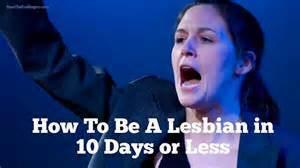
Campus Reform: An upcoming LGBTQ seminar at the University of South Carolina Upstate (USCU) will teach students How to Be a Lesbian in 10 Days or Less and will focus on LGBTQ cultural mores.
According to the school’s website, theater artist Leigh Hendrix will perform her one-woman show, How to Be a Lesbian in 10 Days or Less, to kick off the sixth Bodies of Knowledge Symposium and Conference.
The show is a one-hour performance that follows Butchy McDyke, a motivational speaker and expert lesbian, as she “deftly guides her captive audience in an exploration of self-discovery and first love, coming out, lesbian sex, queer politics, and a really important Reba McEntire song.”
Hendrix encourages her audience to shout “I’m a big ‘ol dyke!” in a show that is “one part instructional seminar, one part personal story, and one party wacky performance art.”
The symposium is funded by outside grants as well as university funds according to Dr. Lisa Johnson, the Director of the Center for Women’s & Gender Studies at USCU.
Dr. Johnson declined to discuss what percentage of the funding was coming from the university.
“Until you call and ask how much money has been spent on heterosexual literature, I’m not going to answer that question,” Johnson told Campus Reform.
Earlier this month, the South Carolina House of Representatives voted to cut almost $70,000 in funding for two public universities, including $17,142 from USCU, over literature containing gay themes.
The symposium will also include presentations of papers from students, faculty, and community members “on topics related to LGBTQ lives and culture.”
“In a historical moment that defines ‘gay,’ ‘lesbian,’ and ‘trans’ according to highly assimilative models, we hope to document, analyze, and disrupt this too-easy cultural knowingness about what it means to be, become, advocate for, recognize, or represent any element of ‘the’ LGBTQ community (as if there is one unified community), as well as the various identities included in, compelled by, or excluded from that community,” reads a call for papers.
Suggested topics include queer places and regions, and LGBTQ uses of social media such as “the queerness of instagram, the transness of tumblr, displays of compulsory heterosexuality on Facebook,” and “the lesbigay selfie.”
Scheduled talks during the conference include “Trans, but Not Like You Think” and “The Extraordinary Lives of Bible Belt Gays.” The two panel discussions are titled “Queer Moods, Moody Queers” and “How to Be Queer.”
It’s not as if the good Doctor has an agenda to push or anything. From her web site:

Currently at work on a new book about disorganized attachment style and the spiral of addictions, frustrations, and neurological misfires it has produced in the first year of her very own Borderline/Narcissist marriage, Johnson continues to search for new and better meanings in the opaque moments of intimacy management. A late-blooming lesbian-after-marriage, Johnson currently resides in South Carolina where she performs a curious balancing act as author, professor, writing consultant, and Women’s & Gender Studies program administrator.
She lives with her ftm transqueer spouse, Austin, and their two loyal shih tsus…”
From her book:
“For the majority of TOURNIQUET, much of the confusion, panic, and chaos in Johnson’s life centers around her affair with a married co-worker, Emily. Johnson clearly recognizes this relationship as being CO-DEPENDENT (she often capitalizes words or phrases for emphasis). She is able to see herself as enmeshed with Emily and neurotically attached to her, yet she is unable to perceive a way to break free from this self-destructive path. About two-thirds of the way through the book, Johnson finally makes the connection that her symptoms are consistent with BPD. Not only does this help her to view her relationship with Emily in a new light, but also she is able to better understand her behavior in subsequent relationships–including a brief fling with one of her students–in terms of this diagnosis.”
DCG

